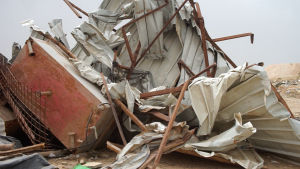Bullets Gone Mad

In the nightly eviction in January 2017 performed by the Israeli police forces the Bedouin dweller Yakub Abu al-Quian and the Israeli police officer Erez Levi died. The circumstances how these deaths came about were never truthfully revealed to the public by state of Israel. Almost right after the deaths Israeli propaganda jumped in and al-Quian was claimed a terrorist. The authorities had to retract the accusations and promised an investigation that a year later was closed without giving any further revelations to the public.
»Bullets gone mad« (2018) retells the story of the Bedouin village Umm Al Khiran in the Israeli Negev where Hagenbach taped the voices of human rights’ activists Rabbi Arik Ashermann and Karen Isaacs retelling the shooting they had witnessed there. We only hear their voices while we look at the strong and static pictures of the demolished Bedouin houses.
This film sits in the frame of occupation and dispossession — the state of Israel was not erected in an empty land — and reveals how the very mechanisms of power may look like. We see the action of the eviction taking place through the lens of a drone and the sound footage is from someone’s cellphone. The sound footage and the aerial drone footage are taken from the media that started to show them when it became clear the official statements were fowl.
“There was an amazing amount of friendly fire” reports one of the by-standing activists what he experienced. We can only partly imagine how the nightly invasion of state power was run. The powerful still images of destructed houses let us ask why and what state power has intended by doing so. Obviously the state wanted its power to be felt hard on the people and the visual results of its might were intended to be seen afterwards. Only the action of the eviction had to take place in the cover of the night. But if power of authority has to rely on such signs, how accepted is it then by its citizens, if we assume they are considered as such.